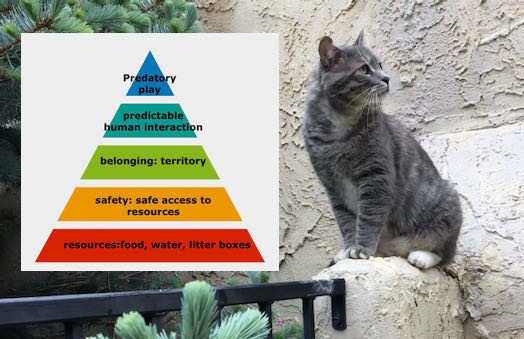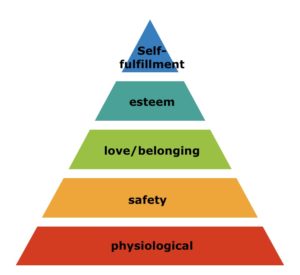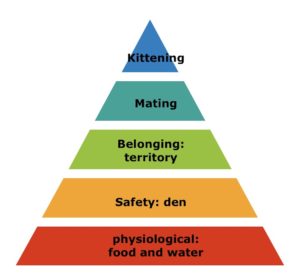
What do cats need to be healthy and happy? Whether you are a new cat owner or someone who has owned a number of cats, this is a question that needs some careful thought.
Your cat is not human; he/she is a different species. After all, if you were going to have a tiger as part of your household, you would need to learn something about how tigers live in the wild to set up an appropriate habitat. Zoos have found that providing an environment that allows animals to engage in behavior typical of their species reduces mental and physical health problems.
This post was originally published on 7/4/2021. It has been rewritten and updated with new references on 2/17/24.
What do cats need – Healthy Feline Environments
Let’s start with ourselves. Many philosophers and psychologists have come up with answers to what humans need for a happy and fulfilled life. One of the simpler models is that proposed by the psychologist Abraham Maslow in 1943 (Reference 1).
Needs and motivation
Maslow postulated that people are motivated by five types of needs (Reference 1):
- Physical needs (food, water)
- Safety
- Love/belonging
- esteem
- self-fulfillment (be all that you can be)

As an individual satisfies needs in one of these categories, he is motivated to tackle the next level.
- What motivates behavior at the most basic level is the need to survive. We need to eat and drink to stay alive.
- Having satisfied these needs, the next step is to ensure that we will continue to have food and water. We need shelter and a job.
- Once fed and secure, we can address the need to be part of society – to belong to a group.
- The next level of needs is esteem: we need to value ourselves and feel that other people value us.
- We are now at the top of the pyramid. We can work on reaching self-imposed goals: maybe become a writer or artist, nurture extended family, or climb mountains.
There is flexibility in this hierarchy- some needs are met at the same time; for some individuals, reaching your full potential may be more important than the esteem of others.
Let’s apply this thinking to cats. We’ll start with the wild cats – those secretive, un-owned cats that populate neighborhoods and barns.
what do cats need? wild cats
- A wild cat’s needs begin with having prey to eat.
- Once fed, he will find a safe place where he can sleep, eat and retreat from danger – like a den.
- He must establish his territory where he can hunt regularly and have access to food.
- A well-fed wildcat who hunts successfully has good prospects for mating.
- As far as Nature is concerned, the wildcat has reached his or her full potential once he or she has ensured that there will be another generation to hunt and mate, continuing the species.

When food is plentiful, some cats will group together in colonies near the food source. The colony forms around breeding females with some unrelated male cats in the colony that help with kitten care and protection. A colony fulfills safety and belonging for a wild cat.
what do cats need? Domestic cats
Things are a bit different for the cat who lives with humans. Hunting and establishing a territory have become separate from getting enough food; our house cats are spayed and neutered, so do not have a drive to mate and reproduce. We can construct a hierarchy showing what do cats need for the cats that live with us.
the 5 pillars of a healthy feline environment
The American Association of Feline Practitioners (AAFP) list five things that make a healthy environment for a cat (Reference 2).
- A safe place
- Multiple and separated key environmental resources
- Opportunity for play and predatory behavior
- Positive, consistent and predictable human-cat social interaction
- An environment that respects the cat’s sense of smell and other senses
We can assemble these needs into a pyramid diagram:
- At the bottom of the pyramid are the needs for survival: food, water, and litter boxes.
- The next level ensures that these essential resources are available to each cat to use safely, without fear of competition or interference from other cats, pets or humans. The cat owner should provide multiple and separated feeding, watering stations and litter boxes.
- One of the AAFP requirements is an environment that respects the cat’s sense of smell and other senses. Such an environment is the cat’s territory. Cats will mark walls and furniture in the home with facial pheromones and scratching posts with pheromones released when scratching. Your cat belongs to his territory.
Thinking about cats as aloof and independent would most likely consider the cat’s needs are met at this point.

the cat-human bond
Our cats share basic physiological needs with their wild relatives. But the domestic cat has chosen a different path and has some different needs because of his bond with his human caregiver. The two final levels of the pyramid are 4) positive and predictable human interaction and 5) the opportunity for predatory play.
- Human Interaction: To truly feel safe and secure in her territory, a housecat needs to know how the humans in the house will behave: when will she be fed? Will they approach quietly and greet her? Will they swoop down on her and pick her up when she least expects it and hold her dangling in the air?
- Predatory Play: The need to hunt defines who your cat is – this is what he was born to do. We need to provide our cats with an opportunity to hunt – whether it is fishing kibble out of a food puzzle or chasing a stuffed mouse at the end of a wand toy.
These last two needs bring us to the heart of the cat-human bond.
Positive and predictable interactions allow us to communicate with our cats; predatory play helps us recognize the cat’s nature as a born hunter and allows us to share this essential part of his life.
We are one of the “5 Pillars of a Healthy Feline Environment”.
In return for helping our cats satisfy their needs, we humans enjoy the pleasure of our cats’ company, better heart health and reduced stress and anxiety.
references
- Taylor S, St Denis K, Collins S, et al. 2022 ISFM/AAFP Cat Friendly Veterinary Environment Guidelines. Journal of Feline Medicine and Surgery. 2022;24(11):1133-1163. doi:10.1177/1098612X221128763




4 thoughts on “What do cats need?”